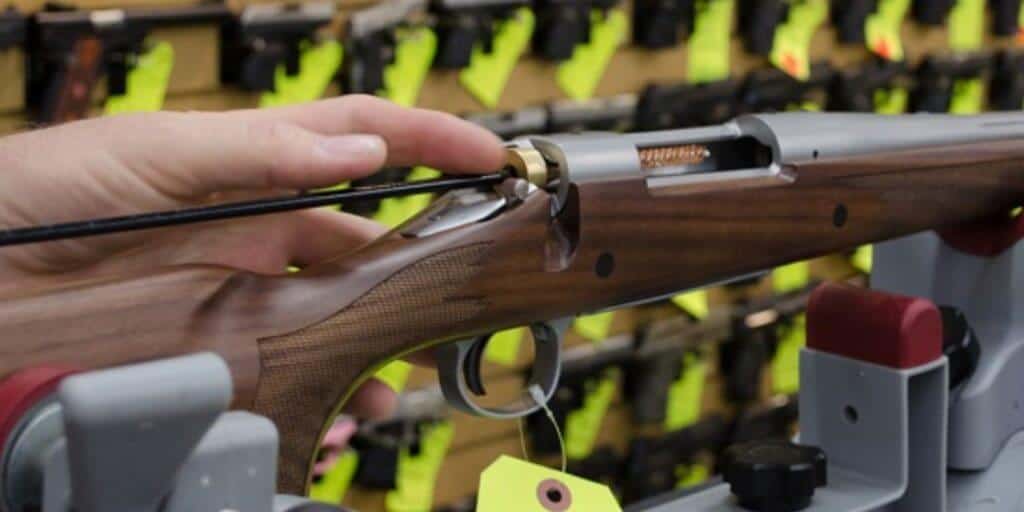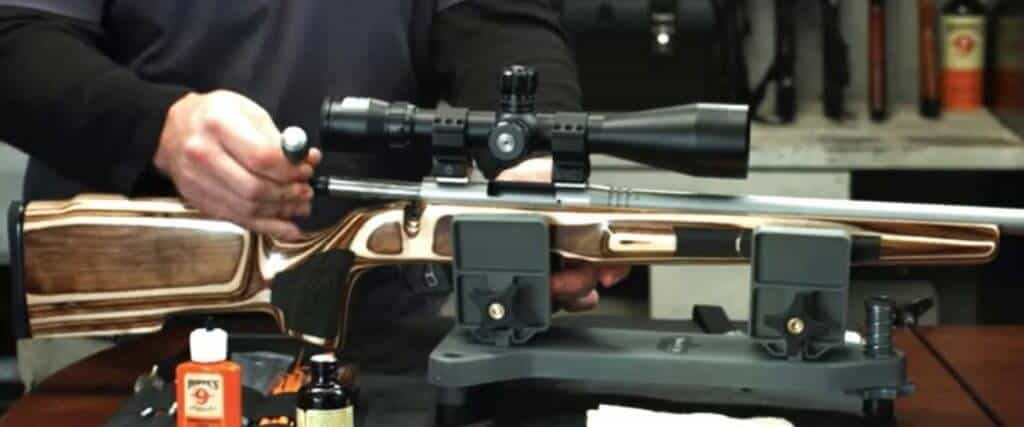Before hunting season starts, make sure you and your rifle are in excellent form. Go to the range to practice your aim and shooting positions. As for your gun, a good cleaning is in order after about 3-4 trips to the range.
In this article, we will show you how to properly clean a rifle. Keep in mind, though, that there is no one correct way of cleaning a rifle. Follow the guide and see what works best for you.
The Importance of a Clean Rifle

Your gun is your most important companion in a hunt. It will catch you the prize and even save your life in some circumstances. Therefore, you have to ensure that it functions perfectly before your trip. Otherwise, it is simply dead weight.
Knowing how to clean a gun guarantees that your rifle stays accurate and reliable. It will also keep your firearm looking good as new.
Furthermore, after several rounds of cleaning your gun, you will understand it better and gain more confidence in using it.
Safety
Every gun owner’s priority is always safety. Even when it comes to cleaning your firearm, make certain that you follow proper safety procedures. Here are some guidelines:
- Unload your gun
The most important thing you need to do is to unload your firearm and empty all the magazines. You will avoid any accidental firing if you follow this crucial step.
- Secure your cleaning area
Clear the area or room of all live ammunition, even the magazine you just removed from the gun that you are about to clean.
When placing your rifle on the bench, point the barrel in a safe direction. If you are cleaning your rifle outdoors, make sure it is not pointing towards your house or your neighbors.
- Ensure safety when handling chemicals
The cleaning solvents and oils are toxic to humans and pets. Avoid using a table where people eat to prevent food contamination from the cleaning chemicals.
Always use safety goggles and solvent-resistant gloves when cleaning your gun.
Preparation is Key
Before starting the process, prepare all the necessary tools you will need to ensure that you get to finish cleaning your firearm properly without a hitch.
- Prep your workspace
Find an area with plenty of space, preferably outdoors for good ventilation. If there is no space outside, work in a room near an open window. Keep the place well-lit and well-ventilated.
Use a sturdy workbench or table. Remove any clutter that you won’t need for cleaning.
- Consult the manual
Every firearm that you purchase from a dealer comes with a manual. If it didn’t come with one, or you lost your copy, try visiting the manufacturer’s website. They probably have a softcopy of your firearm’s manual that you can download for free.
The manual usually lists the tools you will need for your gun’s maintenance.
- Get your essential tools
You can purchase a caliber-specific cleaning kit that contains most of the cleaning supplies listed here. However, you can also purchase them individually to fit your preferences.
- Cleaning rod – Many gun owners advise purchasing a single-piece rod that is made of carbon fiber or nylon. The cheaper sectional screwed-together cleaning rods can damage your bore. The rod is coated with a polymer that will protect your bore.
- Cleaning jag – Get your gun model-specific jag. Choose one that’s made of stainless steel, so you do not get a false copper reading.
- Bore guide – This is an extremely helpful tool for both beginners and experienced owners. It helps speed up the cleaning process. Choose one that has an O-ring to prevent excess solvent from entering back into the action.
- Bore brush – Get a gun model-specific brush made of phosphor bronze. Stainless steel will wreck your barrel. Nylon brushes take forever to scrub anything clean.
- Cleaning patches – Purchase the correct size for your rifle caliber. It is made of absorbent cloth materials. Never use paper towels as these may leave bits inside your barrel. A cheaper option is to cut fabric from old shirts. Just make sure to cut them to the right size to fit your bore.
- Cotton swabs – These are very useful for reaching crevices and tiny areas. Use it to remove rust from your bolt action rifle.
- Cleaning chemicals (bore cleaners, action cleaners, lubricants) – The basic ones you’ll need are a carbon remover, a copper fouling remover, and lubricants. These are used to clean and lubricate the moving parts of your gun to keep it functioning properly. You can also purchase CLP (Cleaner/Lubricant/Preservative) wipes.
- Disposable drip pan – Make sure to have this on hand to catch all the excess chemicals you use for cleaning. It will keep your workspace clean and safe.
- Luster cloth – This is made of soft flannel that is treated with silicone. Use it after cleaning your weapon. It leaves a shine on your gun’s surface that will repel dirt and fingerprint marks.
Other materials:
- Safety glasses or goggles – Wear them to prevent chemicals and fumes from getting into your eyes.
- Solvent-resistant gloves – Wear these to keep your hands safe and clean from the cleaning chemicals.
- Rifle cradle – Use this to safely hold your gun in place while you clean it. You can also use a vise with curved jaws as a substitute.
- Rubber mat – Use it to keep your firearm from scratching the table.
Optional tools:
- Bore snake – This is used for fast and general barrel cleaning, not for a full clean. It is made of soft, easy-to-wash material. It has a built-in brush and sections for the different solvents and cleaning solutions. Run it through the barrel for a quick clean.
- Borescope – An optical device used to take a look inside the barrel. Use it to check for dirt and debris and check that your bore is already clean.
Cleaning and Gun Preparation

Now that you have your tools ready, it is time to prepare your rifle.
- Ensure that your rifle is unloaded and the magazine and any ammo are removed from the room or area.
- Protect your best long-range scope by covering it. Avoid accidentally getting solvents or brush on the lens that might damage it.
- Clamp your firearm in the rifle cradle or gun vise. This will free up your hands to easily clean your gun. The tilt also prevents solvents from getting into the action.
- Remove the bolt and wipe it with a patch dipped in CLP (Cleaner/Lubricant/Preservative). Clean the bolt face with a cotton swab dipped in carbon solvent.
Barrel and Chamber
Take your time in carefully cleaning the barrel and chamber to avoid any damages. Once damaged, the accuracy of your rifle will suffer.
- Place the bore guide into the rifle. This will help in preventing damages to the bore.
- Clean the barrel and chamber with a dry bore brush to remove loose debris and any obstructions. Clean the bore in the direction the bullet travels.
- Next, attach the jag to the cleaning rod. On the tip of the jag, place a cleaning patch dipped in copper fouling remover.
- Push the patch through the barrel of your rifle and out the muzzle, saturating the bore surface. Avoid pulling it back, because this way you will redeposit dirt into the bore.
- Let the cleaning solvent break down bore fouling for about 10-15 minutes.
- Remove the jag, then attach the bore brush to the rod and run it through the rifle bore.
- Once through the bore, apply some drops of copper remover solvent to the brush. Run it through the bore 25-50 times to make sure you scrub all the accumulated grime.
- Attach the jag again. Put a solvent-soaked patch and run it down the bore. Do it 3 times to remove all the copper fouling.
- Then run dry cleaning patches to remove any residue. Keep running a clean patch through the bore. Do this until there are no more streaks or dirt on the patch.
- Repeat the process, this time using a carbon remover solvent.
- After the last dry patch you run through the bore is clean, it is time to lubricate. Use a light lubricant and CLP(Cleaner/Lubricant/Preservative) to clean and treat the surfaces against corrosion.
Never use gun oil to lubricate the bore.
If you plan on storing your gun for quite some time, use a heavier lubricant. Then, before shooting the firearm, remove the lubricant by cleaning the barrel again.
Action
- Clean the action using a utility brush, dry cloth, and action cleaner solvent.
- Spray action liberally with solvent from the top of the frame to wash down carbon and metal debris into the drip pan.
- Allow it to dry before lubricating.
- Follow the manufacturer’s guide on how to oil a gun and lubricate the action and slide assembly.
- Do not over-lubricate. Excess lubricant attracts contaminant build-up which can cause reliability issues.
- Before storing, hold the trigger as you close the bolt to release the firing pin. This will release tension in the firearm.
Check and Clean Magazines
Bolt action rifles only need minor cleaning. The semi-automatic and automatic rifles are the ones that need regular dismantling and general cleaning to operate properly.
- Follow the manufacturer’s instructions when disassembling, cleaning, and reassembling the magazine.
- Never clean the magazine using petroleum products. As these will contaminate the ammunition primers.
- Never lubricate the magazine. Instead, clean it with a residue-free solvent or cleaning agent.
Reassembling and Functional Check
After cleaning and reassembling your firearm, it is essential to check if it functions properly.
- Check the trigger and safety mechanism.
- See if the magazine retention and ejection systems are working fine.
- You can fire a dummy round to check if it functions as it is supposed to.
Clean the Outside of the Rifle
- Properly clean the exterior of your weapon by wiping it with a luster cloth.
- If you do not have a luster cloth, you can use CLP wipes instead.
Extra Tip: Wipe your 300 win mag scope with an alcohol-dampened microfiber cloth. Never spray liquids directly onto the lens.
Conclusion
Learning how to clean a rifle is a must especially before hunting season. It is always a good idea to follow your gun-specific manual to use the appropriate tools, supplies, and procedures to protect it from damage.
When the season’s over, store your rifle in a gun safe and place a dehydrator inside to avoid any rust.
Mike Fellon is an experienced firearms enthusiast and optics expert. He delivers unbiased and detailed rifle scope reviews. Born and raised in Dallas, Texas. He inherited his hunting passions after his father John – he was fascinated by his stories, hearing how much attention, focus, dedication and patience he invested in shooting every animal. When he was old enough, his father first allowed him to shoot some cans and bottles with his shotgun, and then took him hunting – it was love at first sight. Mike has never stopped shooting ever since.


Comments are closed.